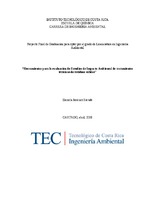Mostrar el registro sencillo del ítem
Herramientas para la evaluación de estudios de impacto ambiental de tratamientos térmicos de residuos sólidos
| dc.contributor.advisor | Dra. Lilliana Abarca Guerrero | es |
| dc.contributor.author | Jiménez-Escudé, Daniela | |
| dc.date.accessioned | 2019-02-13T20:08:38Z | |
| dc.date.available | 2019-02-13T20:08:38Z | |
| dc.date.issued | 2018 | |
| dc.identifier.uri | https://hdl.handle.net/2238/10337 | |
| dc.description | Proyecto Final de Graduación (Licenciatura en Ingeniería Ambiental) Instituto Tecnológico de Costa Rica, Escuela de Química, Carrera de Ingeniería Ambiental, 2018. | es |
| dc.description.abstract | Waste management in Costa Rica has been extensively worked in recent years; however, the high amount of waste that is not being separated and recycled has lead the government to find solutions and allow thermal treatments in 2015 through Decree No. 39136- S-MINAE (Steinvorth, 2014). The current legislation defines "co-incineration" as the thermal treatments of waste with heat recovery produced by combustion, including the incineration by oxidation, as well as pyrolysis, gasification or other processes of thermal treatments. At the same time, the decree establishes that, in order to accept such projects, the SETENA (Secretaría Técnica Nacional Ambiental) should prepare guidelines and procedures for reviewing the Environmental Impact Studies (EIS) of said projects (Decreto Ejecutivo N°39136-S-MINAE, 2015). Due to the limited knowledge that SETENA has about thermal treatments, the Tecnológico de Costa Rica (TEC) was tasked to elaborate the necessary documents for the revision of the EIS, through this Graduation Project. Therefore, this project is aimed to investigate the processes, the ideal conditions and the final products of incineration, gasification and pyrolysis. It will also show the respective legislation and different projects that have been tried to be stablished in the country and finally, analyze which thermal treatment generates less impact on the environment. At the end of the project, two tools were generated: First, the guide to analyze the environmental impacts generated by incineration, gasification and pyrolysis projects for municipal solid waste and a checklist to facilitate the reviewing process. The guide contains the description of the possible environmental impacts that can be generated by the construction and operation of these projects, the mandatory measures by the Costa Rican legislation and recommended measures for each stage of the project. In this way, SETENA is expected to have the capacity to decide whether or not a thermal treatment project will obtain environmental viability. | es |
| dc.language.iso | spa | es |
| dc.publisher | Instituto Tecnológico de Costa Rica | es |
| dc.rights | acceso abierto | es |
| dc.subject | Pirólisis | es |
| dc.subject | Riesgos ambientales | es |
| dc.subject | Manejo de desechos | es |
| dc.subject | Research Subject Categories::NATURAL SCIENCES::Chemistry::Environmental chemistry | es |
| dc.title | Herramientas para la evaluación de estudios de impacto ambiental de tratamientos térmicos de residuos sólidos | es |
| dc.type | proyecto fin de carrera | es |


